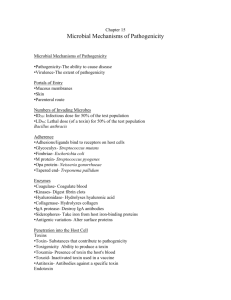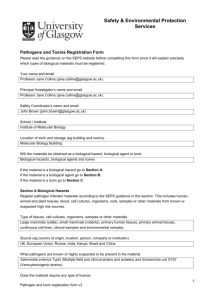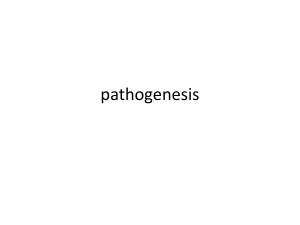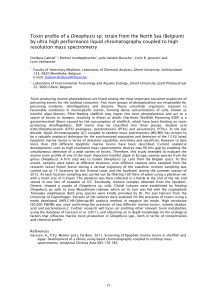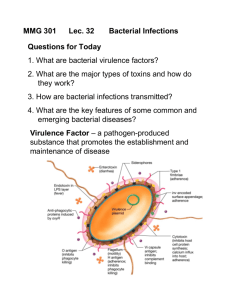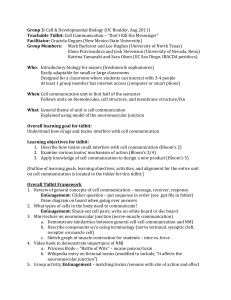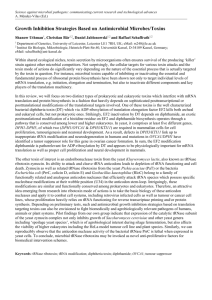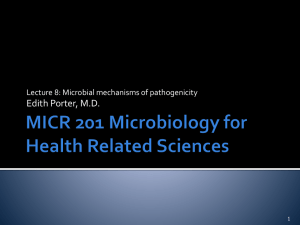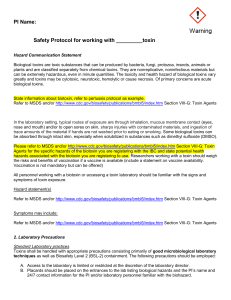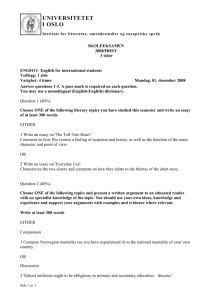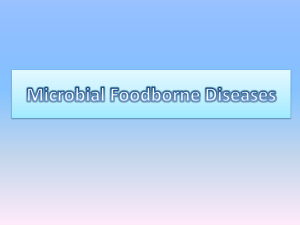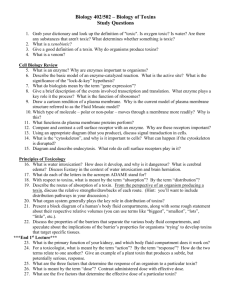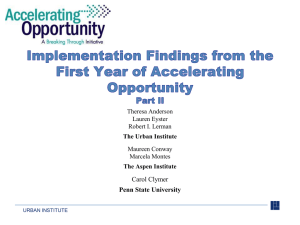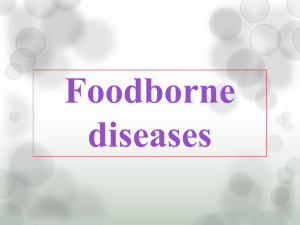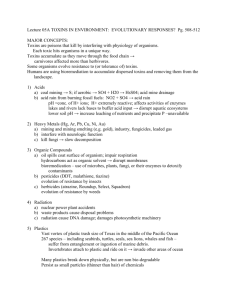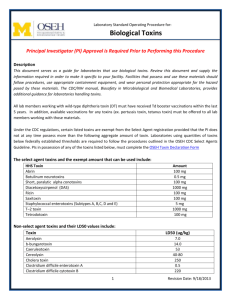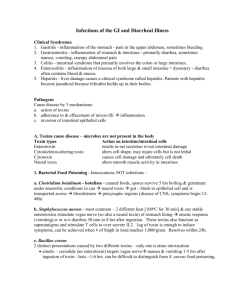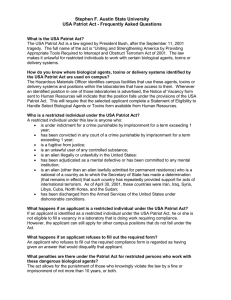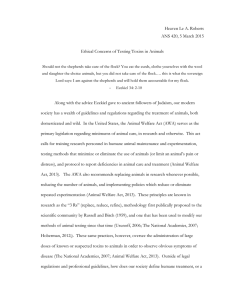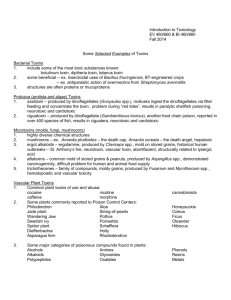Biological Risk Assessment Form
advertisement
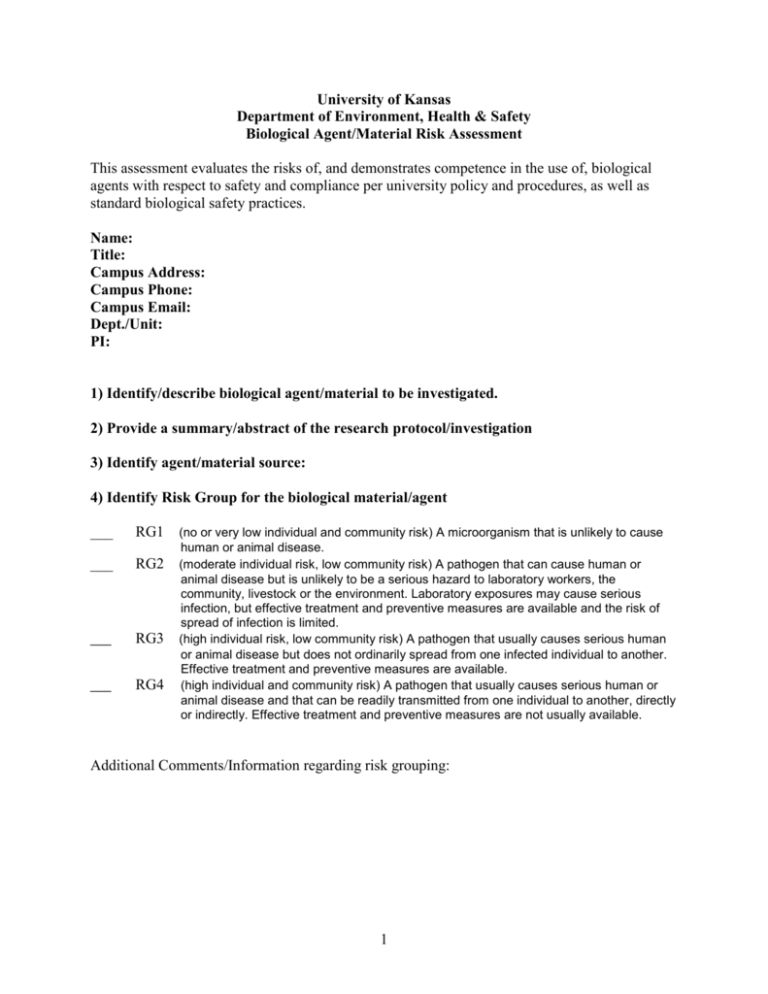
University of Kansas Department of Environment, Health & Safety Biological Agent/Material Risk Assessment This assessment evaluates the risks of, and demonstrates competence in the use of, biological agents with respect to safety and compliance per university policy and procedures, as well as standard biological safety practices. Name: Title: Campus Address: Campus Phone: Campus Email: Dept./Unit: PI: 1) Identify/describe biological agent/material to be investigated. 2) Provide a summary/abstract of the research protocol/investigation 3) Identify agent/material source: 4) Identify Risk Group for the biological material/agent ___ RG1 (no or very low individual and community risk) A microorganism that is unlikely to cause ___ RG2 (moderate individual risk, low community risk) A pathogen that can cause human or human or animal disease. ___ RG3 ___ RG4 animal disease but is unlikely to be a serious hazard to laboratory workers, the community, livestock or the environment. Laboratory exposures may cause serious infection, but effective treatment and preventive measures are available and the risk of spread of infection is limited. (high individual risk, low community risk) A pathogen that usually causes serious human or animal disease but does not ordinarily spread from one infected individual to another. Effective treatment and preventive measures are available. (high individual and community risk) A pathogen that usually causes serious human or animal disease and that can be readily transmitted from one individual to another, directly or indirectly. Effective treatment and preventive measures are not usually available. Additional Comments/Information regarding risk grouping: 1 5) Perform/document risk assessment on materials/activities to be conducted. Address each of the following points pathogenicity of the agent and infectious dose: consideration of the outcome of exposure: natural route of infection: other routes of infection, resulting from laboratory manipulations (parenteral, airborne, ingestion): stability of the agent in the environment: concentration of the agent and volume of concentrated material to be manipulated: presence of a suitable host (human or animal): information available from animal studies and reports of laboratory-acquired infections or clinical reports: laboratory activity planned (concentration, sonication, aerosolization, centrifugation, etc.): any genetic manipulation of the organism that may extend the host range of the agent or alter the agent’s sensitivity to known, effective treatment regimens : local availability of effective prophylaxis or therapeutic interventions: Any medical Surveillance requirements: 6) Identify appropriate biosafety level of containment and practices for working with the materials based on risk and confirm that you have the appropriate facility and capability. 7) Identify location on campus where work will be conducted (Bldg., Rm#, etc.) 2 8) Will this material be used in animal studies/research? Yes or No. If yes, identify IACUC AUS protocol #: 9) Is the material/agent a listed HHS/USDA Select Agent (i.e., complete virus, bacteria, fungi, or toxins)? Yes or No. If yes, identify/describe 10) Does the material/agent meet on one of the conditions below? Y N (a) Select agent or toxin that is in its naturally occurring environment provided the select agent or toxin has not been intentionally introduced, cultivated, collected, or otherwise extracted from its natural source. Y N (b) nonviable select agent organisms or nonfunctional toxins. Nonviable agents or fixed tissues that are, bear, or contain select agents or toxins. Also includes genetic elements or subunits of select agents or toxins that are not capable of causing disease.. 11) Does the material/agent consist of Genetic Elements, Recombinant and/or Synthetic Nucleic Acids, and Recombinant and/or Synthetic Organisms from a HHS/USDA Select Agent? Y N (a) Nucleic acids that can produce infectious forms of any of the select agent viruses? Y N (b) Recombinant and/or Synthetic nucleic acids that encode for the functional form(s) of any of the toxins? (i) Can be expressed in vivo or in vitro, or (ii) Are in a vector or recombinant host genome and can be expressed in-vivo or in-vitro. Y N (c) Select Agent or toxin that has been genetically modified? 3 12) Is the material select toxin that is excluded due to aggregate amount of the toxin under the control of a principal investigator does not, at any time, exceed the established aggregate limit? Yes or No. If yes, identify/describe how excluded. 13) Is the material/agent one of the attenuated strains of HHS Select Agents and Toxins that is excluded? Yes or No. If yes, identify/describe how excluded. 14) Is the material/agent one of the attenuated strains of Overlap Select Agents that is excluded? Yes or No. If yes, identify/describe how excluded. 15) Is the material/agent one of the attenuated strains of USDA-only select agents that is excluded? Yes or No. If yes, identify/describe how excluded. Prepared By: ___________________ Name ___________________ Signature _______ Date EHS Approval: __________________ Name ___________________ Signature ________ Date IBC Approval: ___________________ Name ___________________ Signature ________ Date EHS Biosafety Approval#: __________________ 4

